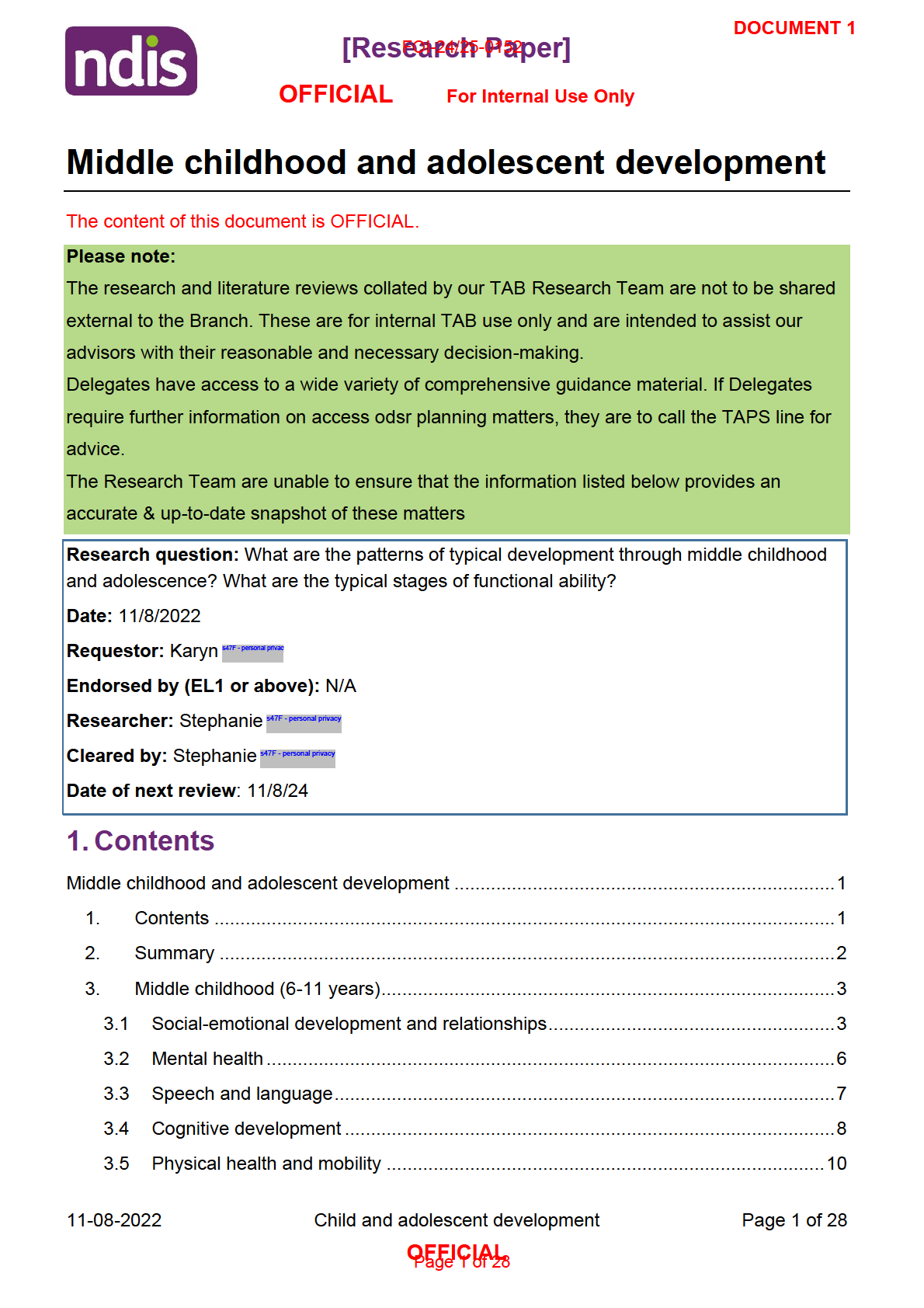
 [Research Paper
[Research Paper
FOI-24/25-0152
]
OFFICIAL
For Internal Use Only
3.6
Self-care .................................................................................................................. 12
4.
Adolescence to late teens (12-18 years) ..................................................................... 14
4.1
Social-emotional ability and relationships ................................................................ 14
4.2
Mental Health .......................................................................................................... 16
4.3
Speech and language .............................................................................................. 17
4.4
Cognitive development ............................................................................................ 18
4.5
Physical health ........................................................................................................ 19
4.6
Self-care .................................................................................................................. 21
4.7
Independence .......................................................................................................... 22
5.
References ................................................................................................................. 24
2. Summary
Children face different challenges at different age stages of their development; therefore, this
research is divided into middle childhood (6-11 years) and adolescence to late teens (12-18
years). Research for early childhood (0-5 years) can be viewed in the TAB research paper
Research - Expected abilities and challenges for children under 5.
Middle childhood is the period where formal education is started. In Australia, most children
have started primary school by the time they turn 6 years old. Factors that influence a child’s
academic achievement include school readiness, the child’s motivation and learning
orientation, parental attitudes, and the classroom and school environment and policies. During
middle childhood, children begin to develop independence by spending greater amounts of
time away from home while they are at school, with peers or participating in extra-curricular
sporting and social activities, however parents and family still play a key role in their overall
development.
In Australia, most children have started secondary school the year they turn 12 years old. At
this level, students typically spend 7 hours each weekday and just over 1 hour each day on the
weekend to complete their educational activities. This includes going to classes, participating
in extracurricular activities such as sport or music, and their homework. Some children find the
transition from primary school to secondary school difficult and become disengaged from their
learning, which can result in long term negative consequences for their academic performance
and their health. Through adolescence, many teenagers will start a part-time job either around
school hours or over the school holidays. Having a job can boost independence as they learn
commitment to a new task, have the opportunity to learn new skills, get ideas for their future
vocation, and earn some money for things they would like to purchase. Teenagers can apply
for their driver’s learner permit by time they turn 16 years old.
11-08-2022
Child and adolescent development
Page 2 of 28
OFFICIAL
Page 2 of 28
 [Research Paper
[Research Paper
FOI-24/25-0152
]
OFFICIAL
For Internal Use Only
3. Middle childhood (6-11 years)
3.1 Social-emotional development and relationships
Children in middle childhood spend less time with their parents than during early childhood but
continue to make many demands on parents (Louw & Louw, 2020). This includes parents
transporting children to activities, supervising and assisting with homework, and supporting the
child’s behavioural learning in different contexts (e.g., school, community). During these years,
children gradually become less dependent on their parents and want opportunities to make
decisions affecting their life (Louw & Louw, 2020). As children demonstrate increased capacity
to complete activities and make thoughtful decisions, effective parents gradually allow the child
to have greater responsibility (Louw & Louw, 2020).
Self-regulation.
Self-regulation is the ability to manage behaviour and reactions to things happening around
you, and includes (Raising Children Network, 2021a):
• Regulation of reactions to strong emotions like frustration, excitement, anger and
embarrassment
• Calming down after being excited or upset
• Focussing attention on a task by ignoring surrounding distractions
• Impulse control to enable turn taking in games or sharing stories
The brain area responsible for self-regulation, the prefrontal cortex, is not fully developed until
around 25 years of age. This means that while children in middle childhood have better
regulation than when they were in early childhood, they can still struggle at times with
impulsivity and an inability to regulate strong emotions (Bertoldo, 2020; Raising Children
Network, 2021a). Children in middle childhood need the opportunity to learn how to self-
regulate in different challenging situations, which can be provided through observing how
parents or carers deal with frustration or their modelling of coping strategies during stress
(Bertoldo, 2020), such as going for a walk or mindfulness (Raising Children Network, 2021a),
and at their school through explicit social and emotional learning programs.
Raising Children Network (2021a) suggests the ability to self-regulate can be impacted by
tiredness, illness and changes to routine. Additionally, some environments may be more
difficult to self-regulate in than others (e.g., noisy crowded areas are often more difficult). It
may be beneficial to seek professional help if a child has more tantrums or difficult behaviour
than their peers, behaves in a dangerous manner for themselves or others, if positive
behaviour strategies parents implement are not working, if they have difficulty interacting well
with others, or if they do not have as many communication and social skills as other children
their age (Raising Children Network, 2021a).
11-08-2022
Child and adolescent development
Page 3 of 28
OFFICIAL
Page 3 of 28
 [Research Paper
[Research Paper
FOI-24/25-0152
]
OFFICIAL
For Internal Use Only
Emotional development.
During middle childhood, children show an increasing ability to understand complex emotions
such as pride and shame and they can understand that more than one emotion may be
experienced in a particular situation (Louw & Louw, 2020). There is greater ability to suppress
or conceal their negative emotional reactions, which is associated with greater social
competence and lower problem behaviour. Parents can support their child’s emotional
development by talking about emotions of characters in books or movies, help children
recognise emotions and how their body feels at the time (e.g., nervousness = butterflies in
tummy), teach their child to count to ten or breathe when feeling strong emotions (Raising
Children Network, 2021b). Additionally, parents influence emotional development through
children observing their reaction to difficult situations and through explicit instruction to their
children; parents need to be aware and in control of their own feelings and non-verbal
language when communicating with their child (Louw & Louw, 2020). Some children may need
extra support with emotional development, for example if they make poor decisions due to
frustration or feel strong emotions that are out of proportion to the problem (Raising Children
Network, 2021b).
Influences on social development.
Children are exposed to many social learning experiences in middle childhood that can
influence their development.
• Parents and carers can contribute to child social development in the following ways:
• Direct instruction – explaining values and attitudes to their children; explicitly
informing and advising on specific social situations; scaffolding/building social skills
through different experiences according to the child’s current level of functioning
(Louw & Louw, 2020).
• Indirect socialisation – through everyday actions with their child, parents model skills
and communicate social information and rules. Parents’ response to social
situations, such as being understanding and helpful or aggressive and intolerant can
model social behaviour to their children (Louw & Louw, 2020)
• Social manager – parents manage children’s social experiences and social lives,
including exposure to different people, activities and information. Parents can
choose certain types of environments, such as home, neighbourhood and school.
Parents actively select their children’s activities, set rules around children’s
friendships and whereabouts, and monitor children’s behaviour from a distance. This
can create a burden on some children who need to adapt to new routines and social
scripts, and to changing parental expectations about their behaviour (Louw & Louw,
2020).
• Sibling relationships – siblings are an important source of support for children in middle
childhood, however sibling rivalry also tends to increase as children get older (Louw &
11-08-2022
Child and adolescent development
Page 4 of 28
OFFICIAL
Page 4 of 28
 [Research Paper
[Research Paper
FOI-24/25-0152
]
OFFICIAL
For Internal Use Only
Louw, 2020). Sometimes children feel that their sibling gets more attention or more
material resources than themselves, triggering resentment. Occasionally sibling bullying
can occur, which is linked to competitive and hostile sibling relationships.
• Peer relationships – in middle childhood children tend to interact more with other
children of their age and gender, which tends to give an opportunity for social skills
development including cooperation, negotiation, and compliance with peer-group rules
that lead to acceptance (Louw & Louw, 2020). As children are becoming better at
controlling their emotions, they play games that involve rules, winning and playing fair
(Raising Children Network, 2022a).
• Friendships – middle childhood sees the emergence of loyal and faithful friendships
built on personal qualities. Friendships at this age are becoming more complex, and it is
normal for children to have fewer friends than in early childhood due to the selective
nature of friendships at this stage (Louw & Louw, 2020). Friendships are fairly stable
over middle childhood, and through this relationship children learn about emotional
commitment – friendships can survive disagreements and tolerate criticism when
friends are secure in their liking for each other (Louw & Louw, 2020).
Challenges.
• Bullying – being bullied can affect a child’s confidence and self-esteem.
• School refusal – some children may become upset and agitated at the thought of going
to school. This may manifest as emotional dysregulation, complaints of physical illness,
and/or anxiety symptoms such as sleeplessness. Understanding the reason for school
refusal can help parents and teachers work out a solution (Raising Children Network,
2021c).
• Difficult behaviour – challenging boundaries and rules is normal through pre-teens and
adolescence as children test out independent ideas and ways of behaving (Raising
Children Network, 2021d). This can involve disrespectful behaviour towards parents or
risk-taking behaviours. If it extends to mood changes, school absenteeism or withdrawal
from previously enjoyed activities then seeking professional support from school
counsellors and/or their general practitioner may beneficial (Raising Children Network,
2021d).
• Understanding and managing difficult emotions – strong emotions can be overwhelming
for children and they may need support from those around them to help calm them
because: they are still developing self-regulation skills, they don’t always have the
words to express how they feel, they may have a temperament that makes them feel
things more strongly, or they might find it hard to calm down in certain environmental
(such as busy, noisy shopping centres) (Raising Children Network, 2021e). Parents and
carers can support their children to calm down by staying calm themselves and
supporting their child while they calm down. Some children with aggressive behaviour,
such as children with autism spectrum disorder or attention deficit hyperactivity
11-08-2022
Child and adolescent development
Page 5 of 28
OFFICIAL
Page 5 of 28
 [Research Paper
[Research Paper
FOI-24/25-0152
]
OFFICIAL
For Internal Use Only
disorder, may need extra support to manage their strong feelings and control impulses
– this support can be guided by their therapist/care team (Raising Children Network,
2021e).
• Body image and eating problems can emerge in middle childhood as children become
more aware of their body and changes due to puberty (Centers for Disease Control and
Prevention, 2021a).
3.2 Mental health
Mental health is described as how children think and feel about themselves and the world
around them and can impact how children manage challenges and stressors in their life
(Raising Children Network, 2021f). Raising Children Network (2021f) suggests that good
mental health in this age group looks like:
• Children feeling happy and positive about themselves
most of the time
• Children are kind to themselves when times are difficult or when things do not go as
planned
• Children appear to enjoy life, learn well and get along well with family and friends
• Children can manage their sad, worrying or angry feelings and bounce back from tough
times
• Children are prepared to try new or challenging things.
Mental health is linked to resilience, the ability to ‘bounce back’ after a challenging event or
adapt to changing circumstances (Raising Children Network, 2021g). To support a child’s
mental health, parents can: tell their child they love them unconditionally, use positive and
consistent approaches for behavioural learning and consequences, be available to talk and
listen each day, and take time to enjoy doing activities together regularly (Raising Children
Network, 2021f).
Mental Health Disorders.
Data from the
Young Minds Matter survey, a household survey conducted in 2013-14,
estimated that almost 14% of Australian children aged 4-11 years experienced a mental health
disorder in the preceding 12 months. Of these 72% were considered a mild mental health
disorder, 20% moderate and around 8% were considered severe (Australian Institute of Health
and Welfare (AIHW), 2022). The most common disorder was attention deficit hyperactivity
disorder (ADHD), followed by anxiety, conduct disorder and major depressive disorder (AIHW,
2022).
Diagnosis of a mental health disorder places the child at risk of school absenteeism, with the
greatest amount of school missed for children with major depressive disorder (average 14
days per year). On average, children with ADHD miss around 4 days per year of school
11-08-2022
Child and adolescent development
Page 6 of 28
OFFICIAL
Page 6 of 28
 [Research Paper
[Research Paper
FOI-24/25-0152
]
OFFICIAL
For Internal Use Only
(AIHW, 2022). Additionally, average NAPLAN scores in the 2013-14 survey were lower for
children with mental disorders (AIHW, 2022).
3.3 Speech and language
Children in middle childhood develop their language skills through watching others and by
practicing their reading, talking and listening at home and at school with teachers and friends.
Play provides the opportunity for children to practice their language skills, however parents
who can take the time to read with their child, sing songs together, tell jokes, discuss the day
and ask open ended questions, and chat while doing activities with their child can help to
further develop their child’s vocabulary and language skills (Raising Children Network, 2021h).
Speech.
At around 5-6 years old, a child’s speech should be mostly clear and easy to understand
however some immature sounds may still be evident; by 7-8 years old there should be no
noticeable errors in speech sounds when talking and an unfamiliar person should understand
almost everything the child says (Kid Sense Child Development Corporation, n.d. a; Raising
Children Network, 2022b).
Language.
Raising Children Network (2021i) suggests a child at 5-6 years old will know many sounds that
go with different letters of the alphabet and start to understand these sounds make up words.
By 6 years old most children have started to read simple stories based on high frequency (e.g.,
and, the, that) and phonetic words (e.g., dog, cat, bin). Children this age can start to combine
words to form active sentences (e.g., the cat chased the dog) and understand passive
sentences (e.g., the dog was chased by the cat) (Raising Children Network, 2021i), however
word tense and grammar can still be challenging (Raising Children Network, 2021h). The
ability to form correct sentences will continue to improve over the next few years (Raising
Children Network, 2021i). By 6 years old, most children can understand and follow three-step
directions they are given (Raising Children Network, 2021i).
Children aged 6-7 years start to understand that single words can have different meanings
depending on context (e.g., ‘cool’ as in cold and ‘cool’ as in awesome). They start to use
longer words by joining two together (e.g., whiteboard) and understand that adding prefixes
and suffixes to words can change the information (e.g., wrap and unwrap, teach and teacher)
(Raising Children Network, 2021i).
At 8 years old many children will understand most of what they are reading and can read their
grade-level texts on their own (Raising Children Network, 2021i). Children start to understand
non-literal language, sarcasm and jokes that use language in an abstract way (Louw & Louw,
2020). They can express ideas, explain their thoughts and describe in detail what happened
through the day (Raising Children Network, 2021h). Children at 8 years old will start to form
compound sentences using words such as ‘but’ or ‘because’ to join sentences together. At this
age, children start to get better at telling and writing stories by adding more details, using more
11-08-2022
Child and adolescent development
Page 7 of 28
OFFICIAL
Page 7 of 28
 [Research Paper
[Research Paper
FOI-24/25-0152
]
OFFICIAL
For Internal Use Only
interesting vocabulary and making them longer with a logical sequence (Raising Children
Network, 2021i).
Challenges.
Raising Children Network (2021i) suggest seeking professional help for language development
if:
• At 6 years old a child is difficult to understand or does not speak in full sentences, has
trouble following two step directions or has stopped using language they once had, or
• At 8 years old a child has a stutter or lisp when speaking, has difficulty following
instructions or has stopped using a language skill they once had,
• If a parent/carer or teacher suspects a learning difficulty such as dyslexia or a disorder
such as auditory processing disorder.
Children who have ongoing speech errors/difficulties may experience problems with
socialisation due to their language delay. The speech errors may impact fluency and clarity of
speech, result in trouble with spelling due to articulation errors, and impact expressive
language development (Kid Sense Child Development Corporation, n.d. b).
Self-regulation and temperament can affect a child’s conversation skills. Some children
interrupt other people when they cannot control their own urge to speak, which can affect their
social network. When children are 6-7 years old, children should know they can interrupt if
something urgent or dangerous is happening but in other situations they should be taught to
wait by being reminded about not interrupting, teaching them to say ‘excuse me’ and then
waiting for their turn, and praising the child as they develop the ability to wait (Raising Children
Network, 2020a).
Children may talk back or back chat after being given limits, instructions or consequences.
Some strategies to manage these situations include: responding calmly and remind the child of
family rules, give a consequence for the rudeness, and avoid laughing or giving a lot of
attention that may encourage back chat in the future (Raising Children Network, 2020a).
3.4 Cognitive development
At around 7 years of age, children enter a new phase of cognitive development called the
‘concrete operational stage’ (Louw & Louw, 2020). This phase enables children to develop a
better understanding of cause and effect so they can see how their actions affect other people
and events (Raising Children Network, 2022a). Children are very inquisitive and ask a lot of
questions, and at times might do small experiments to test how things work or ‘what happens
if’. The advancement in cognitive ability leads to problem solving and reasoning skills based on
logic, however at this age children still have difficulty with hypotheticals and understanding
abstract information (Louw & Louw, 2020).
Working/short term memory improves during middle childhood, helping children with learning
tasks such as reading, understanding language, building vocabulary, and use of mental
11-08-2022
Child and adolescent development
Page 8 of 28
OFFICIAL
Page 8 of 28
 [Research Paper
[Research Paper
FOI-24/25-0152
]
OFFICIAL
For Internal Use Only
imagery (Louw & Louw, 2020). Long term memory also improves at this age, meaning larger
amounts of information can be recalled at a later date. Between 9-11 years old, children
become more strategic and learn memory techniques from teachers and parents, leading to
improved organisational skills as they use their own memory aids (Louw & Louw, 2020).
Other cognitive abilities, such as attention, processing speed and automatic processing, also
improve through this developmental stage (Louw & Louw, 2020). However, because so much
is happening in life at this age, it can be normal for children to get distracted and forget small
requests and directions from others (Raising Children Network, 2022a).
Some of the common milestones children may reach in middle childhood are (Children’s
Health of Orange County (CHOC) Primary Care, 2021a; Healthline, 2019):
• 6-7 years old: understand the concept of numbers, know daytime from night-time,
differentiate left and right, copy complex shapes such as a diamond, understand time,
understand commands with three separate instructions, explain objects and their use,
repeat three numbers backwards, read age-appropriate texts.
• 8-9 years old: can count backwards, know the date, decipher to read more words and
read for enjoyment, understand fractions, understand the concept of space, draw and
paint, name the days of the week and put into order, enjoy collecting objects.
• 10-12 years old: can write stories and letters, see events/opinions from different
perspectives, can use common devices such as phones, tablets and gaming stations,
maintain a longer attention span and sit for longer periods than when they were
younger.
Pre-teens are building their independent decision-making skills. Parents can support their child
in this process by discussing pros and cons of different options, discussing what can be done if
things do not go to plan, and give advice and feedback when their child does make an
independent decision (Raising Children Network, 2021j). Pre-teens with additional needs may
take a bit longer to reach independence than other children, but parents can be guided by their
child’s professional care team about when and how to support the child to independently
manage decisions (Raising Children Network, 2021j).
Challenges.
Poor working memory is associated with problematic classroom behaviour such as inattention
and distractibility (Louw & Louw, 2020). Poor working memory can also impact a child’s ability
to complete tasks as they are unable to follow multiple verbal instructions given at once and
invariably miss some steps (Tyler, 2020).
Learning disabilities often present in middle childhood as children start school and do not
achieve the same level of academic performance as their peers. Learning disabilities are
defined as a specific impairment of academic learning that interferes with a specific aspect of
schoolwork that significantly reduces the student’s performance in that domain (Tyler, 2020).
11-08-2022
Child and adolescent development
Page 9 of 28
OFFICIAL
Page 9 of 28
 [Research Paper
[Research Paper
FOI-24/25-0152
]
OFFICIAL
For Internal Use Only
Common learning disabilities are dyslexia (reading), dysgraphia (writing) and dyscalculia
(maths).
3.5 Physical health and mobility
Nutrition.
It is typical for a child’s appetite to vary day to day. As a parent, it is important to support
healthy eating habits by providing healthy food and the opportunity to eat it – it is then up to
the child to decide how much they would like to eat (Raising Children Network, 2021k).
Encouraging healthy eating habits starts in the home; strategies include (Raising Children
Network, 2021k):
• Getting the child to help with meal planning and food preparation
• Eating healthy meals as a family
• Turning screens off during mealtimes
• Stocking the house with a variety of healthy foods
• Teaching them to pack a healthy lunchbox for themselves
Beginning to involve children in family cooking during middle childhood has the benefit of
helping them to build maths skills and vocabulary, follow stepped instructions, and develop
food preparation skills that will promote independence as they get older (Raising Children
Network, 2019a). In middle childhood, children should have the ability to help with dishes,
clean up the table, and prepare some foods such as peeling vegetables and mixing
ingredients, but they may still need support and supervision around the sharp knives, the oven,
hot-plates and hot liquids (Raising Children Network, 2019a).
Physical ability.
During middle childhood, children enjoy pushing themselves physically and developing more
complex mobility skills, such as running in a zig-zag pattern, jumping downstairs and doing
cartwheels (Raising Children Network, 2022a). Gross motor skills like kicking a ball and
skipping are improving, however skill development depends on how often these activities are
practised. Similarly, fine motor skills are more refined than the early years and children should
be able to brush their teeth and tend to hygiene needs without help (Raising Children Network,
2022a).
Encouraging children to be physically active each day is important to improve cardiovascular
health, boost immune system, develop strong muscles and bones, improve posture, maintain a
healthy weight, and promote good mental health (Raising Children Network, 2022c). From the
age of 5 years old, Australian guidelines recommend at least one hour of moderate to vigorous
physical activity each day, and several hours of light physical activity each day; at least three
times per week this should be activities that strengthen muscles and bones like running,
jumping, climbing and lifting (Raising Children Network, 2022c). Physical activity is important
11-08-2022
Child and adolescent development
Page 10 of 28
OFFICIAL
Page 10 of 28
 [Research Paper
[Research Paper
FOI-24/25-0152
]
OFFICIAL
For Internal Use Only
for children with additional needs, even if activities need to be modified to enable participation
(Raising Children Network, 2022c). Providing an opportunity for children with additional needs
to get outdoor physical activity will enable them to get vitamin D and also help build movement
skills (Raising Children Network, 2022c).
Puberty and sexual development.
Puberty is considered early if it starts before 8 years in girls or 9 years in boys, and late if it has
not commenced by 13 years in girls and 14 years in boys (Raising Children Network, 2021l).
Many physical changes occur during puberty and parents can support this phase by openly
talking about and explaining concerns around puberty and encouraging healthy eating,
physical activity and healthy sleep routines (Raising Children Network, 2021m). Children with
additional needs typically go through puberty the same as other children, however those with
chronic health problems may cause a delay in the onset of puberty (Raising Children Network,
2021m).
Most sexual behaviour in middle childhood is typical and a healthy part of development. In
middle childhood, this may involve wanting to touch their genitals, wanting privacy, kiss or hold
hands with other children, or wanting to talk to others (including children) about sex (Raising
Children Network, 2019b). Being open and honest about sex, bodies and relationships will
help children to develop healthy sexual behaviours and relationships later (Raising Children
Network, 2019b).
Sleep.
During middle childhood, children need 9-11 hours sleep per night (Raising Children Network,
2020b). Children who do not sleep well are often more susceptible to depression, anxiety and
low self-esteem; inadequate sleep is also associated with overweight, possibly due to
disrupted hormone function that regulates hunger (Louw & Louw, 2020). Good quality sleep
improves cognitive function, helping the child to concentrate, remember things, and regulate
their emotions and behaviour (Raising Children Network, 2020b). Parents can help their child
get a good night sleep through implementing a bedtime routine (e.g., put pyjamas on, clean
teeth, go to the toilet then bed at a set time), practice mindfulness before bed to relax, and
consider turning off screens and dimming light an hour before bedtime (Raising Children
Network, 2020b).
Challenges.
• Bedwetting – some children wet the bed after toilet training because they sleep very
deeply, and other children may have bladder spasms overnight. Children who continue
to wet the bed at 7-8 years old may benefit from assessment by their general
practitioner (Raising Children Network, 2020b).
• Obstructive sleep apnoea – some children may occasionally stop breathing while
asleep, evident as snoring, an audible pause, or a struggle to breath at night. The poor
quality of sleep may cause the child to be tired the next day, impacting their functional
11-08-2022
Child and adolescent development
Page 11 of 28
OFFICIAL
Page 11 of 28
 [Research Paper
[Research Paper
FOI-24/25-0152
]
OFFICIAL
For Internal Use Only
capacity (Raising Children Network, 2020b). Assessment by a general practitioner is
recommended.
• Night terrors – night terrors are less common than nightmares, and often stop occurring
by puberty. Nightmares are common for school age children and often wake the child
up. As children get older they become more aware that it is just a dream (Raising
Children Network, 2020b).
• Sleep walking – occurs when a child’s mind is asleep but their body is awake. It usually
doesn’t need any treatment, and children often grow out of the behaviour during their
adolescence (Raising Children Network, 2020b).
• Problematic sexual behaviour – some sexual behaviour isn’t typical and might be a sign
of something more serious that requires professional support. In school age children,
this might include persistently rubbing or touching genitals in public, persistently flashing
their genitals or bottoms to other children, persistently using coarse sexual or explicit
language, wanting to play sexual games with much older or younger children, forcing or
tricking other children into playing sexual games, and/or repeatedly wanting to look at or
touch the genitals or other children or adults (Raising Children Network, 2020c).
3.6 Self-care
Self-care skills are activities of daily living that need to be undertaken to participate in life
activities. In the early stage of middle childhood, many of these activities are typically
supported by adults until the child develops the skill to successfully complete the activity on
their own (Kid Sense Child Development, n.d. b). It is important to note, however, the age
children can independently complete activities of daily living will depend on the learning
opportunities they receive. For example, if an 8-year-old child wears shoes that use Velcro
then they are not receiving the opportunity to practice and learn shoelace tying so it would be
expected they would continue to need parental support if shoes with laces were worn.
Screening checklists obtained online through therapy clinic websites (Kid Sense Child
Development, n.d. b; Skills for Life Paediatric Therapy, 2021) suggest that, given the learning
opportunity, by the age of 8 years old many children can independently:
• Open lunch boxes, zip lock bags and food packaging
• Pack a bag for school or other outing with little prompting
• Self-regulate in busy or noisy environments
• Shower, wash hands and face
• Brush their hair and teeth
• Toilet themselves through the day and night
• Dress themselves, including tying shoelaces, doing up buttons and zips
11-08-2022
Child and adolescent development
Page 12 of 28
OFFICIAL
Page 12 of 28
 [Research Paper
[Research Paper
FOI-24/25-0152
]
OFFICIAL
For Internal Use Only
• Help with some household chores such as making their bed, tidy their playroom
• Follow the classroom routine, such as putting their bag away and swap readers
• Tell the time and display some time management skills
• Feed themselves using utensils
• Prepare simple meals such as cereal or a sandwich
• Settle independently for sleep
The mid-to-late middle childhood stage is an important time for parents and caregivers to
reinforce personal hygiene habits in preparation for adolescence and puberty (Raising
Children Network, 2021n). Parents and caregivers can role model these habits and explain to
their children the importance of maintaining good hygiene habits as they grow up. The Raising
Children Network (2021n) highlight the following situations:
• Body odour – teaching children they need to change their underwear and clothes that
sit next to the skin every day is important as these clothes collect sweat and body fluids
that promote body odour. As puberty approaches, children develop a new type of sweat
gland in their armpits and genital areas, so learning how to use antiperspirant deodorant
can help stop body odour.
• Dental hygiene – parents and caregivers need to encourage children this age to brush
their teeth at least twice a day, floss their teeth and take them to the dentist regularly.
• Periods – some girls will start getting periods through middle childhood. They will need
parental support to learn how often to change their menstrual products and how they
should dispose of it or clean it hygienically.
• Shaving – some children may want to start shaving through middle childhood. They will
need parental support to learn how to safely use shaving products.
• Young people with additional needs will need extra time and support as they learn how
to maintain good personal hygiene through middle childhood and into adolescence. To
support learning and skill development, tasks can be broken down into smaller steps –
such as shower, brush hair and clean teeth. A written routine schedule may make it
easier for some children to learn what they need to do each day for their hygiene.
Learning how to maintain good personal hygiene is important for a child’s health and
confidence. Washing hands before eating and after the toilet can fight off germs and potential
sickness. There is also a social benefit to maintaining good hygiene – if a child’s body and
breath smell okay and their clothes are clean, they will usually feel more comfortable around
their peers and other people (Raising Children Network, 2021n). The earlier a parent or carer
begins to have conversations around hygiene and encourages good habits the more likely
these habits will be continued into adolescence (Raising Children Network, 2021n).
11-08-2022
Child and adolescent development
Page 13 of 28
OFFICIAL
Page 13 of 28
 [Research Paper
[Research Paper
FOI-24/25-0152
]
OFFICIAL
For Internal Use Only
Fire safety.
A literature review completed in 2022 by the Technical Advisory Branch Tactical Research
Team, titled ‘Effectiveness of standard and specialised smoke alarms to wake children and
adults’, found that children aged 5-12 years old do not have a reliable waking response from
deep sleep. Consequently, this age group have a higher reported fatality rate in residential
fires than teenagers or adults as they are more likely to sleep through an alerting fire alarm
(He & Nelson, 2007; Smith et al, 2022). It was also found that when children this age do
awaken, they often become disorientated and afraid, and may hide which further increases the
risk of perishing in the fire (Fire and Rescue New South Wales, 2017; Willoughby, 2009). Due
to the unreliable waking response of children in this age-group, they are still reliant on parental
and caregiver support to escape a house in the event of a fire (Willoughby, 2009).
Challenges.
Successfully learning and completing activities of daily living requires explicit skills training and
structured practice, including gradually increasing the difficulty of tasks, provided in natural
contexts such as the home and school environment. Caregiver and family involvement to both
model skills and provide the opportunity for practice is essential in supporting children in the
early and middle years to develop skill mastery to complete activities of daily living
independently (Beisber and Cahill, 2021).
Professional advice is recommended if a child struggles with the self-care activities at 8 years
old (Raising Children Network, 2022a):
• Dressing and undressing independently
• Daytime wetting or soiling
• Regular night-time wetting the bed
4. Adolescence to late teens (12-18 years)
4.1 Social-emotional ability and relationships
Social and emotional development.
Children between 12-14 years old are starting to show more interest in, and influenced by,
their peer group, and express more concern about body image, their looks and the clothes
they wear (CDC, 2021b). Adolescents respond well to social rewards during activities and
prefer to be around others their age (Tyler, 2020). Nonetheless, at this age adolescents also
display an increasing need for privacy (Healthline, 2019). It is common during this
developmental stage for children to be very focused on themselves, and alternate between
high and low confidence (CDC, 2021b).
The adolescent years can be a time of increased moodiness (Healthline, 2019). They may
often feel strong emotions and can be overwhelmed by a sense of shame or humiliation, but
11-08-2022
Child and adolescent development
Page 14 of 28
OFFICIAL
Page 14 of 28
 [Research Paper
[Research Paper
FOI-24/25-0152
]
OFFICIAL
For Internal Use Only
still might not have the skill to express and manage their emotions (Raising Children Network,
2021o). Some will feel stress and anxiety from the increasing challenge of schoolwork (CDC
2021b). This may lead to sadness or depression for some adolescents, increasing the risk of
poor academic achievement and/or risky behaviours (CDC 2021b; CDC 2021c). Having
friends who are high-achieving, motivated and engaged at school can promote the same
feelings in the adolescent, whereas friends who are unmotivated, disengaged and low
achieving can compound these feelings (Tyler, 2020).
As children mature through their teens they may struggle with their identity and question who
they really are. This may lead to questioning about their appearance, vocational choice,
education, relationships, sexuality, social views, personality and interests (Raising Children
Network, 2021o; Tyler, 2020). As teens develop their self-concept, their self-esteem can also
change.
Parents and carers can help their adolescent’s social and emotional development through
(CHOC, 2021b; Raising Children Network, 2021p):
• Encouraging them to try new challenges
• Talk with their adolescent about not losing themselves in their group relations
• Encourage positive friendships
• Talk about how behaviour can affect other people
• Encourage their adolescent to talk to a trusted adult about their problems or worries
• Discuss strategies to handle stress
• Provide consistent, positive discipline with reasonable boundaries
• Spend time together
Relationships.
As children enter adolescence, they may start to show less affection towards their parents and
may sometimes seem rude or short-tempered (CDC, 2021b). Around 15-17 years old, many
teens show more independence from their parents as they choose to spend time with friends
(CDC, 2021c; Healthline, 2019). Conflict with parents may decrease in late adolescence, as
the ability to have a deeper capacity to empathise with others develops (CDC, 2021c;
Healthline, 2019).
More intimate relationships and more interest in romantic relationships and sexuality typically
emerges through the middle to late teenage years (CDC, 2021c). Parents and carers can help
adolescents build respectful relationships through conversations about how people behave in
a respectful relationship, being a role model with their own relationships, giving praise for
respectful behaviour and teaching or showing conflict management strategies (Raising
Children Network, 2021q).
11-08-2022
Child and adolescent development
Page 15 of 28
OFFICIAL
Page 15 of 28
 [Research Paper
[Research Paper
FOI-24/25-0152
]
OFFICIAL
For Internal Use Only
Challenges.
• Rule breaking – as teenagers try to increase their independence they may go through a
stage of breaking family or school rules. Ignoring the rule breaking may help avoid
conflict in the short term but may highlight to children that there is no point following
rules. Calmly discussing the broken rule with positive discipline and consequences can
reinforce expectations of behaviour (Raising Children Network, 2022d).
• Bullying – can be emotional or physical. During adolescence, cyberbullying becomes
more common and can occur in text messages, emails, online games and social media
platforms. Cyberbullying can lead to low self-esteems, disengagement from school, low
academic achievement, and mental health issues such as depression, anxiety, stress
and suicidal thoughts. Adolescents with a disability or mental health issue can make
them more vulnerable to cyberbullying. Placing rules around technology use at home
such as only ‘friending’ people they know, thinking before they post online, and limiting
time on technology can reduce the chance of cyberbullying (Raising Children Network,
2022e).
4.2 Mental Health
Good mental health supports healthy development, strong relationships, and adaptability to
change and challenges (Raising Children Network, 2021r). Adolescence is a risky time for
mental health problems as teenagers go through many changes and challenges through this
period.
Signs that may be a warning for mental health problems include (Raising Children Network,
2021r):
• Feelings of hopelessness, being tearful or lacking motivation
• Difficulty coping with everyday activities
• Sudden changes of behaviour for no apparent reason, including being aggressive or
antisocial
• Changes to eating or sleeping patterns
• Suddenly doing less well at school or refusing to attend
• Avoiding friends or social contacts
• Regularly saying they have physical pain, such as headaches, stomach aches or
backache
• Being aggressive or antisocial
• Being very anxious about their weight or physical appearance, including losing weight
or trying not to gain as they grow.
11-08-2022
Child and adolescent development
Page 16 of 28
OFFICIAL
Page 16 of 28
 [Research Paper
[Research Paper
FOI-24/25-0152
]
OFFICIAL
For Internal Use Only
Professionals that can help teens with mental health problems include the family general
practitioner, counsellors, occupational therapists to manage daily living activities, and
psychiatrists if the mental health concern significantly impacts the teen’s life such as severe
mood disturbance, debilitating anxiety or psychotic disorder (Raising Children Network,
2021s).
Body image.
Body image is how we think and feel about our body and relates to how happy and satisfied
we are with how we look (Raising Children Network, 2019c). A good body image is associated
with good self-esteem and mental health. Body image is influenced by factors such as family
environment, ability or disability, peers, social media, and cultural background. Puberty also
influences how adolescents view their body. Parents and carers can support their teen by
focusing on them as a whole and praising their achievements, not discuss their physical
changes unless the teen starts the conversation, point out unrealistic images on social media,
and being a positive role model by avoiding fad diets, having a healthy lifestyle and not
commenting on how others look (Raising Children Network, 2019c).
Mental health disorders.
The
2013-2014 National Youth Information Framework indicators, a survey of mental health for
adolescents, reported that 14% of adolescents between 12-17 years old had a mental disorder
in the 12 months prior to the survey; males had a higher prevalence (16%) than females
(13%), although this was not a statistically significant difference (AIHW, 2015).
The most common disorders reported were anxiety disorder (e.g., social phobia, generalised
anxiety disorder, obsessive compulsive disorder, and separation anxiety disorder), accounting
for almost half of all the mental disorders in this age group (AIHW, 2015). This was followed by
ADHD (6.3%) and major depressive disorder (5%). For 44% of 12–17-year-olds with a mental
disorder, the impact of the mental disorder was considered mild, 33% had moderate impact
and 23% experienced a severe impact (AIHW, 2015).
4.3 Speech and language
By adolescence, teens should be able to understand word meaning and contexts, punctuation
and form complex sentences and texts (CHOC, 2021b). When queried, the explanations they
provide may become more figurative than literal, and they have a greater capacity to
understand abstract and figurative language such as similes, metaphors and idioms (CHOC,
2021b).
As children progress through adolescence to young adulthood their language skills become
more complex, such as (Healthline, 2019):
• At 12-14 years old, teens can use speech that is not literal; they can use their tone of
voice to communicate intentions, e.g., sarcasm
11-08-2022
Child and adolescent development
Page 17 of 28
OFFICIAL
Page 17 of 28
 [Research Paper
[Research Paper
FOI-24/25-0152
]
OFFICIAL
For Internal Use Only
• At 15-17 years old, teens can speak, read, listen and write fluently and easily; have
complex conversations; speak differently in different groups/to different audiences; write
persuasively; understand proverbs, figurative language and analogies
4.4 Cognitive development
At around 12 years old, children enter what is called the formal operational stage of cognitive
development. During the formal operational stage, adolescents start to understand abstract
principles that have no physical reference, and contemplate abstract constructs as beauty,
love, freedom, and morality (Tyler, 2020). During earlier periods of development children solve
problems through trial and error, however adolescents begin to demonstrate hypothetical-
deductive reasoning – developing hypotheses based on what might logically occur (Tyler,
2020).
Studies have found that executive functions (attention, increases in working memory, and
cognitive flexibility) steadily improve from early childhood through to adolescence (Tyler,
2020). However, self-regulation, or the ability to control impulses, may still be immature in
certain situations such as during high stress or high demand on mental functions (Tyler, 2020).
The limbic system, the brain area that regulates emotion and reward, is linked to the hormonal
changes that occur at puberty and is related to novelty seeking and a shift toward interacting
with peers. In contrast, the prefrontal cortex, involved in the control of impulses, organization,
planning, and making good decisions, does not fully develop until the mid-20s. The different
rates of regional brain development can create a challenge for teens with respect to risky
behaviour, poor decision making, and weak emotional control (Tyler, 2020).
Although the exact timing for cognitive maturity varies among children, it is expected the
following characteristics are evident during the following age ranges (CDC, 2021b; CDC,
2021c; CHOC, 2021; Healthline, 2019):
• 12-14 years old:
o develop own opinions different to their peers and parents
o develops awareness that parents or carers are not always correct
o have a better understanding of figurative language
o greater ability for complex thought, logical thinking is improving but still maturing
o better able to express feelings through talking
o has developed a stronger sense of right and wrong
• 15-17 years old:
o learn more defined study habits
o show more concern around future school and work plans
o sets long-term and short-term goals
11-08-2022
Child and adolescent development
Page 18 of 28
OFFICIAL
Page 18 of 28
 [Research Paper
[Research Paper
FOI-24/25-0152
]
OFFICIAL
For Internal Use Only
o better able to give reasons for their own choices, including about what is right or
wrong
o think more abstractly
o shows greater concern for politics and social issues
4.5 Physical health
Nutrition.
During puberty, children are often hungrier because they go through a major growth spurt and
require extra energy to support this growth (Raising Children Network, 2021t). It is common for
teenagers to want to eat fewer healthy foods such as fruit and vegetables in preference for
fatty and sweet junk foods. As teenagers get more independent with their food choices,
parents and carers can encourage healthy nutrition by (Raising Children Network, 2021t):
• Being a healthy eating role model and showing how to make consistent healthy choices
• Eat regularly through the day to highlight the importance of eating regular meals
• Encourage the adolescent to help with family shopping and meal preparation
• Limit unhealthy options in the home
• Do not talk about restricting food or that some food is bad, explain balance
• Teach to eat when they are hungry and stop when they are full; recognise hunger cues
Physical activity.
Physical activity guidelines for teenagers recommend they get a minimum of 1 hour of
moderate to strong physical activity each day (CDC, 2021c; CHOC, 2021b). Most of this time
should be spent doing aerobic exercise, such as running, swimming or dancing. With
supervision, teens can undertake sports that include strengthening exercises such as weights
(CHOC, 2021b).
Puberty and sexual development.
The physical changes associated with puberty continue through the teenage years; the time
for puberty to finish varies for each child but can be anywhere from 18 months to 5 years
(Raising Children Network, 2021u). At around 11-14 years old, most children will have a
growth spurt; girls tend to stop growing taller by 17 years old and boys 18-20 years old. Boys’
voice will get deeper, girls will start to menstruate monthly, both sex’s sexual organs will get
bigger, and they will get pubic hair (Raising Children Network, 2021u). Parents and carers can
help this phase of development through open communication, reassurance and support if their
child expresses concern (Raising Children Network, 2021v).
Typically, through adolescence, teenagers develop their sexuality and sexual identity. They
learn that sexual attraction and sexual identity are not the same, and that sexual attraction
differs from gender identity (Raising Children Network, 2021w). Gender identity is the sense of
11-08-2022
Child and adolescent development
Page 19 of 28
OFFICIAL
Page 19 of 28
 [Research Paper
[Research Paper
FOI-24/25-0152
]
OFFICIAL
For Internal Use Only
who they are – male, female, both or neither. A person is cisgender if they identify with the
same sex they were given at birth, or gender diverse which includes (Raising Children
Network, 2021x):
• Transgender – gender identity does not match the sex given at birth
• Non-binary – gender identity is neither male or female, or is a blend of male and female
• Gender fluid – person moves between gender identities
• Agender – does not identify with any gender.
Adolescents learn about sexuality from their parents, at school, with their friends, and online.
Having open conversations at home can help teenagers navigate this sometimes-confusing
period (Raising Children Network, 2021w).
Sleep.
Most teenagers need between 8-10 hours sleep to maintain physical health, energy levels,
good mental health, cognitive performance and social relationships (CDC, 2021c; Raising
Children Network, 2022f). During adolescence it is common for children to want to start to go
to bed later at night and rise later in the morning as their circadian rhythm undergoes changes
in the timing of melatonin secretion, making it hard for them to get to sleep early in the night
(CHOC, 2021b; Raising Children Network, 2022f). As they progress to late adolescence,
children can stay awake for longer as their brain matures.
To support teenagers to get the sleep they require (Raising Children Network, 2022f):
• Encourage them to keep a consistent sleep routine during the school week and
weekends. Keeping wake-up time to within 2 hours of each other will help keep their
body-clock regular.
• Make the hour before lights out to be screen free and do relaxing activities like read a
book, have a warm shower or listen to music.
• In the bedroom, avoid the use of electronic devices and keep the room dimly lit.
• Eat healthy food during the day and do some physical activity.
• Talk or write about worries before going to bed so they do not ruminate.
• Use mindfulness or breathing exercises to calm the mind and body before sleep.
Challenges.
• Gender dysphoria – may develop during adolescence and is when they feel distressed
that their gender identity differs from the sex assigned at birth. This distress may impact
their psychological, social and academic functioning or manifest as self-harm (Raising
Children Network, 2021x); gender dysphoria may be associated with bullying, stigma or
discrimination from their gender identity.
11-08-2022
Child and adolescent development
Page 20 of 28
OFFICIAL
Page 20 of 28
 [Research Paper
[Research Paper
FOI-24/25-0152
]
OFFICIAL
For Internal Use Only
• Acne – acne is common through puberty because of hormonal changes causing
overactive sebaceous (oil-producing) glands leading to pimples on the skin (Tyler,
2020). Approximately 85% of adolescents develop acne, and boys develop acne more
than girls because of greater levels of testosterone in their systems (Tyler, 2020). Acne
can lead the adolescent to withdraw socially, especially if they are self-conscious about
their skin or teased (Tyler, 2020).
• Unhealthy eating – habits such as eating too much, too little or restricting food groups
can affect an adolescent’s health and wellbeing (Raising Children Network, 2021t).
Promoting healthy eating habits may reduce the risk of these issues.
• Eating disorders – the risk of anorexia, bulimia and avoidant restrictive food intake
disorder is high during adolescence as they become aware of their body image and
ideal self-identity (CDC, 2021b; Raising Children Network, 2021t). The family general
practitioner or a dietician can provide advice with concerns about eating disorders.
4.6 Self-care
During adolescence, teenagers increase their self-care skills through making personal
decisions like their food choices, exercise habits, sleep pattern, hygiene routine, and social
behaviours. Teenagers can also contribute to tasks at home that build their independence,
such as learning to cook, changing bed linen, washing clothes, and cleaning. Parents can help
their teen develop self-care skills through modelling positive lifestyle choices and providing an
opportunity for the teen build skills.
Healthy food choices.
Nutritious food is important for the growing teenager. Parents can encourage healthy food
choices and support their teen to develop self-care skills by giving them the opportunity to try
new recipes for the family and learning about how to budget the grocery money. While teens
are still developing their food preparation skills in the kitchen they will need supervision around
sharp knives, electrical appliances, hot stoves and ovens (Raising Children Network, 2019a).
Personal hygiene.
Personal hygiene through adolescence builds on the skills developed as pre-teens, for
example regular showering, brushing hair and brushing teeth, and extends to tasks like period
care, body odour, and shaving. Good personal hygiene is important for health and confidence.
As outlined earlier in the Middle Childhood Section 3.6 – Self-care, particular hygiene concerns
for pre-teens and teens include (Raising Children Network, 2021n):
• Body odour – during puberty new sweat glands become active in armpits and genital
areas, so maintaining a regular shower routine, changing clothes daily and using
antiperspirant deodorant will help reduce body odour.
• Dental hygiene – adolescents should brush their teeth at least twice a day, floss their
teeth and visit the dentist regularly.
11-08-2022
Child and adolescent development
Page 21 of 28
OFFICIAL
Page 21 of 28
 [Research Paper
[Research Paper
FOI-24/25-0152
]
OFFICIAL
For Internal Use Only
• Periods – when girls start to menstruate, they will need parental support to learn how to
use and change their menstrual products to maintain good hygiene.
• Shaving – some adolescents will want to start shaving as they develop body hair; they
will need parental support to learn how to safely use shaving products.
• Young people with additional needs will need extra time and support as they learn how
to maintain good personal hygiene through middle childhood and into adolescence. To
support learning and skill development, tasks can be broken down into smaller steps –
such as shower, brush hair and clean teeth. A written routine schedule may make it
easier for some children to learn what they need to do each day for their hygiene.
Screen time.
Teenagers use screens for their schoolwork, entertainment and socialising. As they spend a
lot of time on screens, and often use more than one screen at a time, it is important that
teenagers know how to make healthy choices about when and how to use screens in their free
time (Raising Children Network, 2020d). Teenagers who are unable to find a balance between
screen use and other activities are at risk of poor sleep, being sedentary, and experiencing
online issues such as cyberbullying or encountering inappropriate content (Raising Children
Network, 2020e).
Alcohol and other drugs.
Some teenagers may experiment with alcohol or other drugs, however it can also be a sign of
serious problems and lead to substance abuse and poor mental health. There is no safe level
of alcohol or drug use for children under 18 years old, and use of alcohol or other drugs may
affect their development (Raising Children Network, 2021y). Signs that a teen may be using
alcohol or other drugs might be mood swings, outbursts that are out of character, and big
changes to clothes, friends and interests – although these can also be a typical part of
exploring identity through adolescence (Raising Children Network, 2021y). If parents suspect
alcohol or drug use, talking to their teen with calm and positive language is the first step to
understand the problem. Support from the family general practitioner, counsellor and other
health professionals is available for strategies and advice (Raising Children Network, 2021y).
4.7 Independence
The mid-teen years often see even greater independence of children from their parents as
they move to young adulthood. This stage often involves teenagers exploring work experience
for post-school options, getting a part-time job while finishing their schooling and getting their
driving learners permit and eventually their full license. Parents and carers can support their
teens in developing greater independence by allowing them to try new things, giving them
more responsibility, and allowing them to make some decisions for themselves (Raising
Children Network, 2021j).
11-08-2022
Child and adolescent development
Page 22 of 28
OFFICIAL
Page 22 of 28
 [Research Paper
[Research Paper
FOI-24/25-0152
]
OFFICIAL
For Internal Use Only
• Driving permit - many teenagers are keen to get their learners permit for driving as it
can give a sense of freedom and growing independence from parents (Tyler, 2020).
The following table indicates the minimum age when teens can get their learner permit
and provisional licence by Australian state:
State
Learner Permit
Provisional Licence
NSW
16y
17y
VIC
16y
18y
QLD
16y
17y
SA
16y
17y
TAS
16y
17y
WA
16y
17y
ACT
15y9m
17y
NT
16y
16y6m
• Volunteering – participating in community activities or volunteering can build skills and
boost confidence; it can bolster the idea about civic responsibility and giving back to the
community (Raising Children Network, 2021z). The following Raising Children Network
provides a list of community activities and volunteer organisations and links for state-
based volunteering websites: Community activity & volunteering: teens
• Casual and part time jobs – working part-time or casually while finishing school can give
teenagers a greater sense of independence, learn how to manage time effectively, build
skills for later employment and boost their self-confidence (Raising Children Network,
2021aa). Parents, carers and school counsellors can help teenagers prepare a resume
and tips for interviews.
• Teen education, training and employment services – the following page on Raising
Children Network provides a comprehensive list of links for teen education and
employment through Australia: Teen education and employment links
• Post-school options – parents, carers and school counsellors can guide teenagers
about their post-school pathway. Options include: higher education/university, TAFE,
vocational education and training (VET), apprenticeships, work, or a gap year.
11-08-2022
Child and adolescent development
Page 23 of 28
OFFICIAL
Page 23 of 28
 [Research Paper
[Research Paper
FOI-24/25-0152
]
OFFICIAL
For Internal Use Only
5. References
Australian Institute of Health and Welfare. (2022).
Children with mental illness. Accessed from
https://www.aihw.gov.au/reports/children-youth/australias-
children/contents/health/children-with-mental-illness
Australian Institute of Health and Welfare. (2015).
National youth information framework
(NYIF) indicators. Accessed from https://www.aihw.gov.au/reports/children-youth/nyif-
indicators/contents/health-status-wellbeing/mental-health
Beisbier, S., & Cahill, S. (2021). Evidence Connection—Occupational therapy interventions for
children and youth ages 5 to 21 years.
American Journal of Occupational Therapy,
75,7504390010. https://doi.org/10.5014/ajot.2021.754001
Bertoldo, S. (2020).
Emotional regulation in children. Child Development Clinic. Accessed from
https://www.childdevelopmentclinic.com.au/emotion-regulation-in-children.html
Centers for Disease Control and Prevention. (2021a).
Middle childhood (9-11 years of age).
Accessed from
https://www.cdc.gov/ncbddd/childdevelopment/positiveparenting/middle2.html
Centers for Disease Control and Prevention. (2021b).
Young teens (12-14 years of age).
Accessed from
https://www.cdc.gov/ncbddd/childdevelopment/positiveparenting/adolescence.html
Centers for Disease Control and Prevention. (2021c). Teenagers (15-17 years of age).
Accessed from
https://www.cdc.gov/ncbddd/childdevelopment/positiveparenting/adolescence2.html
Children’s Health of Orange County. (2021a).
Growth & development: 6 to 12 years (school
age). Accessed from https://www.choc.org/primary-care/ages-stages/6-to-12-years/
Children’s Health of Orange County. (2021b).
Teenager growth & development: 13 to 18 years
(adolescence). https://www.choc.org/primary-care/ages-stages/13-to-18-years/
Fire and Rescue New South Wales. (2017).
Smoke alarms in homes: an analysis. Fire
research report. New South Wales Government. Available from
https://www.fire.nsw.gov.au/gallery/files/pdf/research/Fire%20research%20report%20%
20Smoke%20Alarms%20in%20Homes%20An%20Analysis.pdf
Healthline. (2019).
Understanding the stages of child development. Accessed from
https://www.healthline.com/health/childrens-health/stages-of-child-
development#developmental-screening
He, Y., & Nelson, D. (2007). A comparative study of effectiveness of smoke alarms in two
types of buildings.
Journal of Fire Sciences, 26, 415-434.
11-08-2022
Child and adolescent development
Page 24 of 28
OFFICIAL
Page 24 of 28
 [Research Paper
[Research Paper
FOI-24/25-0152
]
OFFICIAL
For Internal Use Only
Kid Sense Child Development Corporation. (n.d. a).
Speech sounds development chart.
Accessed from
https://childdevelopment.com.au/resources/child-development-
charts/speech-sounds-developmental-chart/
Kid Sense Child Development Corporation. (n.d. b).
Self-care development chart. Accessed
from https://childdevelopment.com.au/resources/child-development-charts/self-care-
developmental-chart/
Louw, D., & Louw, A. (2020).
Child and adolescent development (2nd Ed.). Sunbonani Books.
Raising Children Network. (2019a).
Cooking with kids and teens. Accessed from
https://raisingchildren.net.au/school-age/nutrition-fitness/cooking-with-kids/cooking-with-
kids-teens
Raising Children Network. (2019b).
Sexual behaviour in school-age children. Accessed from
https://raisingchildren.net.au/school-age/development/sexual-development/sexual-
behaviour-school-age
Raising Children Network. (2019c).
Body image: pre-teens and teenagers. Accessed from
https://raisingchildren.net.au/teens/healthy-lifestyle/body-image/body-image-teens
Raising Children Network. (2020a).
Conversation skills for children. Accessed from
https://raisingchildren.net.au/school-age/connecting-
communicating/communicating/conversation-skills
Raising Children Network. (2020b).
Sleep for kids & pre-teens: 5-11 years. Accessed from
https://raisingchildren.net.au/pre-teens/healthy-lifestyle/sleep/school-age-sleep
Raising Children Network. (2020c).
Problematic sexual behaviour: 2-18 years. Accessed from
https://raisingchildren.net.au/school-age/development/sexual-development/problematic-
sexual-behaviour
Raising Children Network. (2020d).
Teenage screen time: tips for balance. Accessed from
https://raisingchildren.net.au/teens/entertainment-technology/screen-time-healthy-
screen-use/healthy-screen-time-teens
Raising Children Network. (2020e).
Social media benefits and risks: children and teenagers.
Accessed from https://raisingchildren.net.au/teens/entertainment-technology/digital-
life/social-media
Raising Children Network. (2021a).
Self-regulation in children & teenagers. Accessed from
https://raisingchildren.net.au/school-age/development/school-age-social-emotional-
development/self-regulation
Raising Children Network. (2021b).
Understanding emotions: children & teens. Accessed from
https://raisingchildren.net.au/school-age/development/school-age-social-emotional-
development/understanding-managing-emotions-children-teenagers
Raising Children Network. (2021c).
School refusal: children and teenagers. Accessed from
https://raisingchildren.net.au/school-age/school-learning/school-refusal/school-refusal
11-08-2022
Child and adolescent development
Page 25 of 28
OFFICIAL
Page 25 of 28
 [Research Paper
[Research Paper
FOI-24/25-0152
]
OFFICIAL
For Internal Use Only
Raising Children Network. (2021d).
Behaviour management: pre-teens & teens. Accessed
from https://raisingchildren.net.au/pre-teens/behaviour/behaviour-questions-
issues/behaviour-overview
Raising Children Network. (2021e).
Calming down for children: how to help. Accessed from
Calming down for children: how to help | Raising Children Network
Raising Children Network. (2021f).
Good mental health for children: 3-8 years. Accessed from
https://raisingchildren.net.au/school-age/health-daily-care/mental-health/children-s-
mental-health
Raising Children Network. (2021g).
Resilience in pre-teens & teenagers. Accessed from
https://raisingchildren.net.au/teens/development/social-emotional-
development/resilience-in-teens
Raising Children Network. (2021h).
Play ideas & language skills. Accessed from
https://raisingchildren.net.au/school-age/play-media-technology/play-school-age-
development/talking-play-school-age
Raising Children Network. (2021i).
Language development: 5-8 years. Accessed from
https://raisingchildren.net.au/school-age/development/language-development/language-
5-8-years
Raising Children Network. (2021j).
Pre-teen & teen independence: a guide. Accessed from
https://raisingchildren.net.au/pre-teens/development/social-emotional-
development/independence-in-teens
Raising Children Network. (2021k).
Healthy eating habits for children. Accessed from
https://raisingchildren.net.au/school-age/nutrition-fitness/healthy-eating-habits/healthy-
eating-habits
Raising Children Network. (2021l).
Early puberty & late puberty. Accessed from
https://raisingchildren.net.au/pre-teens/development/puberty-sexual-
development/puberty-early-or-late
Raising Children Network. (2021m).
Puberty: helping children handle changes. Accessed from
https://raisingchildren.net.au/pre-teens/development/puberty-sexual-
development/puberty-helping-your-child
Raising Children Network. (2021n).
Personal hygiene for pre-teens & teens. Accessed from
https://raisingchildren.net.au/pre-teens/healthy-lifestyle/hygiene-dental-care/hygiene-
pre-teens-teens
Raising Children Network. (2021o).
Pre-teen & teenage development: a guide.
https://raisingchildren.net.au/teens/development/understanding-your-teenager/teen-
development
11-08-2022
Child and adolescent development
Page 26 of 28
OFFICIAL
Page 26 of 28
 [Research Paper
[Research Paper
FOI-24/25-0152
]
OFFICIAL
For Internal Use Only
Raising Children Network. (2021p).
Prosocial behaviour in children & teens. Accessed from
https://raisingchildren.net.au/teens/behaviour/encouraging-good-behaviour/prosocial-
behaviour-kindness-children-teens
Raising Children Network. (2021q).
Respectful relationships: 9-18 years. Accessed from
https://raisingchildren.net.au/teens/communicating-relationships/romantic-
relationships/respectful-relationships-for-teens
Raising Children Network. (2021r).
Mental health in pre-teens and teenager. Accessed from
https://raisingchildren.net.au/teens/mental-health-physical-health/about-mental-
health/teen-mental-health
Raising Children Network. (2021s).
Mental health professionals: a guide for pre-teens and
teenagers. Accessed from https://raisingchildren.net.au/teens/mental-health-physical-
health/mental-health-therapies-services/mental-health-professionals-for-teens
Raising Children Network. (2021t).
Healthy eating habits for teenagers. Accessed from
https://raisingchildren.net.au/teens/healthy-lifestyle/healthy-eating-habits/healthy-eating-
habits-teens
Raising Children Network. (2021u).
Physical changes in puberty. Accessed from
https://raisingchildren.net.au/teens/development/puberty-sexual-development/physical-
changes-in-puberty
Raising Children Network. (2021v).
Puberty: helping pre-teens and teenagers handle the
changes. Accessed from https://raisingchildren.net.au/teens/development/puberty-
sexual-development/puberty-helping-your-child
Raising Children Network. (2021w).
Sexuality: pre-teens and teenagers. Accessed from
https://raisingchildren.net.au/teens/development/puberty-sexual-development/teenage-
sexuality
Raising Children Network. (2021x).
Gender identity, gender diversity and gender dysphoria:
children and teenagers. Accessed from
https://raisingchildren.net.au/teens/development/teens-gender-diversity-and-gender-
dysphoria/gender-identity
Raising Children Network. (2021y).
Community activities and volunteering: pre-teens and
teenagers. Accessed from https://raisingchildren.net.au/teens/healthy-lifestyle/alcohol-
other-drugs/alcohol-other-drug-use-how-to-help
Raising Children Network. (2021z).
Alcohol, smoking and other drug use: how to help
teenagers. Accessed from https://raisingchildren.net.au/pre-teens/entertainment-
technology/free-time-activities/community-activity
Raising Children Network. (2021aa). Casual work and part-time jobs for teenagers. Accessed
from https://raisingchildren.net.au/teens/school-education-work/work-careers-further-
study/casual-work-part-time-jobs-teenagers
11-08-2022
Child and adolescent development
Page 27 of 28
OFFICIAL
Page 27 of 28
 [Research Paper
[Research Paper
FOI-24/25-0152
]
OFFICIAL
For Internal Use Only
Raising Children Network. (2022a).
Child development at 6-8 years. Accessed from
https://raisingchildren.net.au/school-age/development/development-tracker/6-8-years
Raising Children Network. (2022b).
Speech disorders & speech sound disorders. Accessed
from https://raisingchildren.net.au/babies/development/language-development/speech-
disorders
Raising Children Network. (2022c).
Physical activity: pre-teens and teenagers. Accessed from
https://raisingchildren.net.au/pre-teens/healthy-lifestyle/physical-activity/physical-
activity-teens
Raising Children Network. (2022d).
When teens break the rules: options. Accessed from
https://raisingchildren.net.au/teens/behaviour/behaviour-management-ideas/rule-
breaking-options
Raising Children Network. (2022e).
Cyberbullying: kids and teens. Accessed from
https://raisingchildren.net.au/teens/behaviour/bullying/about-cyberbullying
Raising Children Network. (2022f).
Sleep and teenagers: 12-18 years. Accessed from
https://raisingchildren.net.au/teens/healthy-lifestyle/sleep/sleep-teens
Skills for Life Paediatric Therapy. (2021).
Activities of daily living. Accessed from
https://skills4lifeot.com/activities-of-daily-living/
Smith, G. A., Kistamgari, S., Splaingard, M. (2022). Optimizing smoke alarm signals for those
at highest risk for residential fire-related death: testing the effectiveness of children’s
smoke alarms for sleeping older adults.
Fire Technology, 58, 311-326.
Tyler, S. (2020).
Human behaviour and the social environment. University of Arkansas.
Willoughby, L. (2009).
Review of the fire alarm subsidy scheme for Deaf and hard of hearing
Victorians. The Victorian Deaf Society, Melbourne.
11-08-2022
Child and adolescent development
Page 28 of 28
OFFICIAL
Page 28 of 28



























